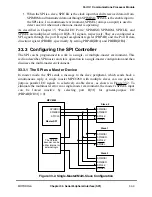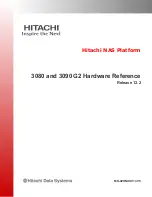
MOTOROLA
Chapter 33. Serial Peripheral Interface (SPI)
33-17
Part IV. Communications Processor Module
8. Initialize the TxBD. Assume the Tx buffer is at 0x0000_2000 in main memory and
contains Þve 8-bit characters. Write 0xB800 to TxBD[Status and Control], 0x0005
to TxBD[Data Length], and 0x0000_2000 to TxBD[Buffer Pointer].
9. Execute the
INIT
RX
AND
TX
PARAMETERS
command by writing 0x2541_0000 to
CPCR.
10. Write 0xFF to SPIE to clear any previous events.
11. Write 0x37 to SPIM to enable all possible SPI interrupts.
12. Write 0x0370 to SPMODE to enable normal operation (not loopback), master mode,
SPI enabled, 8-bit characters, and the fastest speed possible.
13. Set SPCOM[STR] to start the transfer.
After 5 bytes are sent, the TxBD is closed. Additionally, the Rx buffer is closed after 5 bytes
are received because TxBD[L] is set.
33.9 SPI Slave Programming Example
The following is an example initialization sequence to follow when the SPI is in slave
mode. It is very similar to the SPI master example, except that SPISEL is used instead of a
general-purpose I/O signal (as shown in Figure 33-2).
1. Enable SPIMISO, SPIMOSI, SPICLK, and SPISEL.
2. In address 0x89FC, assign a pointer to the SPI parameter RAM.
3. Assuming one RxBD at the beginning of the dual-port RAM followed by one TxBD,
write RBASE with 0x0000 and TBASE with 0x0008 in the SPI parameter RAM.
4. Write RFCR and TFCR with 0x10 for normal operation.
5. Program MRBLR = 0x0010 for 16 bytes, the maximum number of bytes per buffer.
6. Initialize the RxBD. Assume the Rx buffer is at 0x0000_1000 in main memory.
Write 0xB000 to RxBD[Status and Control], 0x0000 to RxBD[Data Length]
(optional), and 0x0000_1000 to RxBD[Buffer Pointer].
7. Initialize the TxBD. Assume the Tx buffer is at 0x0000_2000 in main memory and
contains Þve 8-bit characters. Write 0xB800 to TxBD[Status and Control], 0x0005
to TxBD[Data Length], and 0x0000_2000 to TxBD[Buffer Pointer].
8. Execute the
INIT
RX
AND
TX
PARAMETERS
command by writing 0x2541_0000 to
CPCR.
9. Write 0xFF to SPIE to clear any previous events.
10. Write 0x37 to SPIM to enable all SPI interrupts.
11. Set SPMODE to 0x0170 to enable normal operation (not loopback), slave mode, SPI
enabled, and 8-bit characters. BRG speed is ignored in slave mode.
12. Set SPCOM[STR] to enable the SPI to be ready once the master begins the transfer.
Note that if the master sends 3 bytes and negates SPISEL, the RxBD is closed but the TxBD
Summary of Contents for MPC8260 PowerQUICC II
Page 1: ...MPC8260UM D 4 1999 Rev 0 MPC8260 PowerQUICC II UserÕs Manual ª ª ...
Page 66: ...lxvi MPC8260 PowerQUICC II UserÕs Manual MOTOROLA ...
Page 88: ...1 18 MPC8260 PowerQUICC II UserÕs Manual MOTOROLA Part I Overview ...
Page 120: ...2 32 MPC8260 PowerQUICC II UserÕs Manual MOTOROLA Part I Overview ...
Page 138: ...Part II iv MPC8260 PowerQUICC II UserÕs Manual MOTOROLA Part II Configuration and Reset ...
Page 184: ...4 46 MPC8260 PowerQUICC II UserÕs Manual MOTOROLA Part II ConÞguration and Reset ...
Page 202: ...Part III vi MPC8260 PowerQUICC II UserÕs Manual MOTOROLA Part III The Hardware Interface ...
Page 266: ...8 34 MPC8260 PowerQUICC II UserÕs Manual MOTOROLA Part III The Hardware Interface ...
Page 382: ...10 106 MPC8260 PowerQUICC II UserÕs Manual MOTOROLA Part III The Hardware Interface ...
Page 392: ...11 10 MPC8260 PowerQUICC II UserÕs Manual MOTOROLA Part III The Hardware Interface ...
Page 430: ...Part IV viii MOTOROLA Part IV Communications Processor Module ...
Page 490: ...14 36 MPC8260 PowerQUICC II UserÕs Manual MOTOROLA Part IV Communications Processor Module ...
Page 524: ...17 10 MPC8260 PowerQUICC II UserÕs Manual MOTOROLA Part IV Communications Processor Module ...
Page 556: ...18 32 MPC8260 PowerQUICC II UserÕs Manual MOTOROLA Part IV Communications Processor Module ...
Page 584: ...19 28 MPC8260 PowerQUICC II UserÕs Manual MOTOROLA Part IV Communications Processor Module ...
Page 632: ...21 24 MPC8260 PowerQUICC II UserÕs Manual MOTOROLA Part IV Communications Processor Module ...
Page 652: ...22 20 MPC8260 PowerQUICC II UserÕs Manual MOTOROLA Part IV Communications Processor Module ...
Page 668: ...23 16 MPC8260 PowerQUICC II UserÕs Manual MOTOROLA Part IV Communications Processor Module ...
Page 758: ...27 28 MPC8260 PowerQUICC II UserÕs Manual MOTOROLA Part IV Communications Processor Module ...
Page 780: ...28 22 MPC8260 PowerQUICC II UserÕs Manual MOTOROLA Part IV Communications Processor Module ...
Page 874: ...29 94 MPC8260 PowerQUICC II UserÕs Manual MOTOROLA Part IV Communications Processor Module ...
Page 920: ...31 18 MPC8260 PowerQUICC II UserÕs Manual MOTOROLA Part IV Communications Processor Module ...
Page 980: ...A 4 MPC8260 PowerQUICC II UserÕs Manual MOTOROLA Appendixes ...
Page 1002: ...Index 22 MPC8260 PowerQUICC II UserÕs Manual MOTOROLA INDEX ...
Page 1006: ......
















































